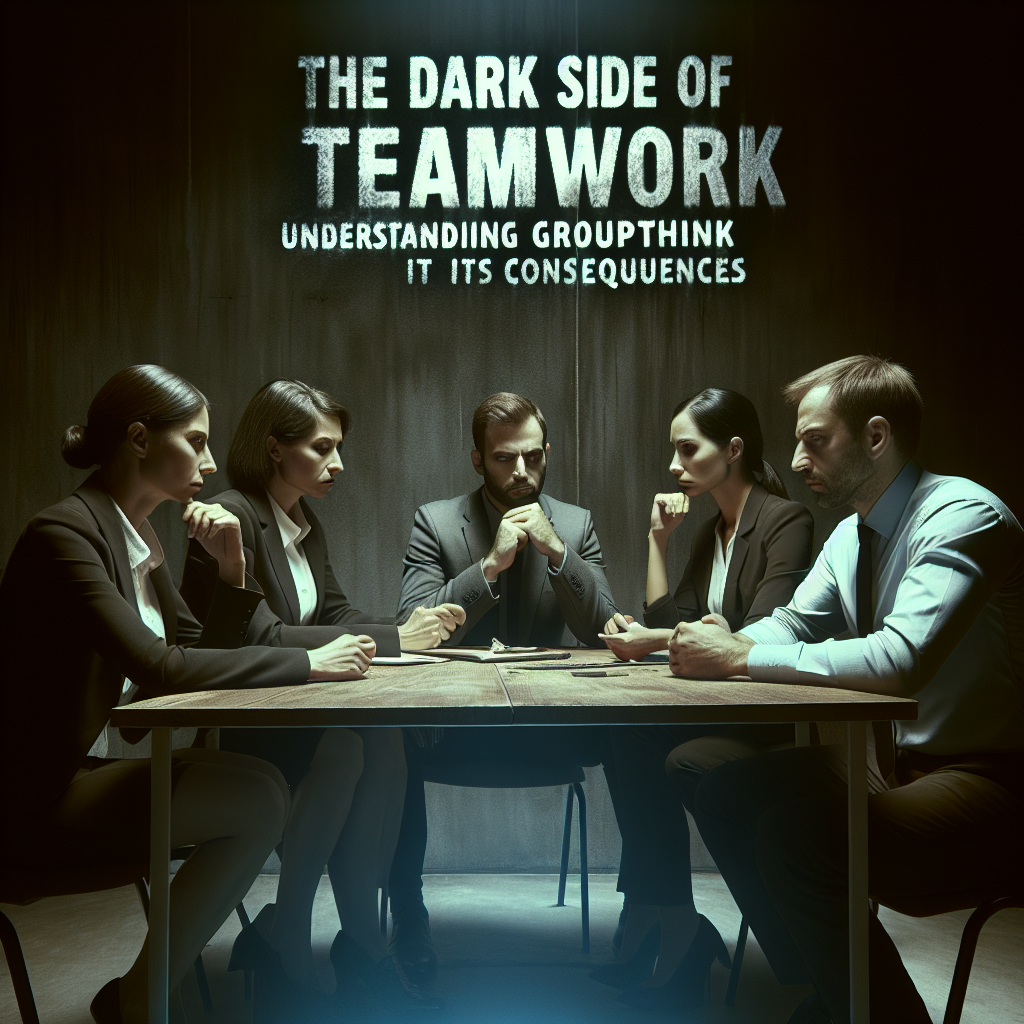
Introduction
In the world of teamwork, collaboration is often seen as a pathway to success, promising innovation and shared victories. However, lurking beneath this collaborative facade is a phenomenon that can spell disaster for teams and organizations alike: groupthink. This article delves into the dark side of teamwork: understanding groupthink and its consequences, revealing how the very collaboration that drives us can also lead us astray.
As teams strive for consensus, they often inadvertently suppress dissent, stifling creativity and paving the way for poor decision-making. How can we navigate these murky waters? This exploration not only seeks to uncover the ramifications of groupthink but also aims to provide actionable insights to ensure your team remains resilient and effective.
Understanding Groupthink
Definition and Origin
Groupthink, a term coined by psychologist Irving Janis in the early 1970s, refers to a psychological phenomenon where the desire for harmony or conformity in a group results in irrational or dysfunctional decision-making. When group members prioritize consensus over critical evaluation, they may overlook viable alternatives or ignore potential consequences, leaving teams vulnerable to significant failures.
Characteristics of Groupthink
Groupthink manifests through several distinct characteristics:
- Illusion of Invulnerability: Team members may develop overconfidence in their decisions, believing they are immune to failure.
- Collective Rationalization: Groups often dismiss warnings and negative feedback, rationalizing poor decisions.
- Belief in Inherent Group Morality: Members may believe their decisions are morally superior, justifying unethical actions.
- Stereotyping of Outsiders: Those outside of the group are often viewed as adversaries or incapable of understanding the group’s objectives.
- Self-Censorship: Individuals may withhold dissenting opinions to avoid conflict.
- Illusion of Unanimity: Silence is often perceived as agreement, leading to a false sense of consensus.
- Direct Pressure on Dissenters: Any member who questions the group’s decisions may experience social pressure or ostracism.
Case Studies Illustrating Groupthink
Example 1: The Bay of Pigs Invasion
One of the most infamous examples of groupthink is the Bay of Pigs Invasion in 1961. Despite serious concerns about the plan’s feasibility, President John F. Kennedy’s advisors failed to voice their doubts, leading to a disastrous outcome. This event serves as a stark reminder of the dark side of teamwork: understanding groupthink and its consequences, where failure to communicate dissenting opinions can lead to national catastrophe.
Analysis
The Bay of Pigs Invasion underscores how the desire for consensus prevented policymakers from evaluating the risks involved. Had team members felt empowered to speak up, the outcome may have been different, highlighting the importance of fostering an environment where dissent is not only tolerated but encouraged.
Example 2: NASA’s Challenger Disaster
Another striking example is NASA’s Challenger disaster. Just before the launch, engineers raised concerns about the O-rings in cold temperatures, yet their worries were downplayed in favor of launching on schedule. This tragedy, which resulted in the loss of seven astronauts, exemplifies the lethal consequences of groupthink in an organization, showcasing the dark side of teamwork: understanding groupthink and its consequences on an epic scale.
Analysis
The Challenger disaster illustrates how groupthink can lead to catastrophic outcomes. Encouraging a culture where team members feel secure enough to express concerns could potentially avert such disasters.
Example 3: Enron’s Rise and Fall
Enron’s collapse provides another case study in groupthink. The company’s executives created a culture where dissent was not only ignored but actively discouraged. The drive for short-term success overshadowed ethical considerations, ultimately leading to one of the most notorious corporate scandals in history.
Analysis
Enron’s downfall is a perfect example of how the dark side of teamwork: understanding groupthink and its consequences can lead to unethical practices and organizational ruin. Implementing checks and balances, such as external audits and anonymous feedback mechanisms, could have altered the course of its history.
The Consequences of Groupthink
Deterioration of Innovation
When creative ideas are stifled in the name of consensus, teams miss out on innovative solutions. An environment of psychological safety is crucial for fostering creativity and exploration.
Increased Risk of Errors
Groupthink often leads to oversight of critical information and details, increasing the likelihood of significant errors. Teams should prioritize critical thinking and diverse perspectives to mitigate this risk.
Ethical Implications
The phenomenon can lead to unethical decision-making when the group collectively rationalizes dubious practices. Maintaining a clear ethical framework and encouraging open dialogue can prevent these scenarios.
Decreased Job Satisfaction
When team members feel their voices are not heard, it can lead to disengagement and dissatisfaction. Organizations must prioritize creating inclusive environments to boost morale and productivity.
Strategies to Overcome Groupthink
Foster Open Communication
Encouraging team members to express their views without fear of backlash is essential. Implementing regular feedback sessions can help create a culture of openness.
Appoint a Devil’s Advocate
Designating a member to challenge assumptions and present counterarguments can stimulate critical thinking and prevent complacency.
Diverse Teams
Creating teams with diverse backgrounds and expertise can combat homogeneity in thought, promoting a wider range of ideas and solutions.
Encourage Independent Thinking
Promote individual accountability by encouraging team members to think independently and contribute their perspectives before group discussions.
Conduct Post-Mortems
Regularly analyzing past decisions and outcomes can help teams identify instances of groupthink and learn from them.
Conclusion
Recognizing the dark side of teamwork: understanding groupthink and its consequences is crucial for effective collaboration. While the desire for harmony can drive teams, it is essential to remain vigilant and proactive in preventing groupthink. By fostering a culture of openness, encouraging diverse perspectives, and instilling the importance of critical thinking, organizations can unlock their teams’ full potential.
To succeed in navigating the complexities of teamwork, remember this: your voice matters. Encourage dialogue, challenge assumptions, and create environments where every perspective is valued. With these principles, you can combat groupthink and harness the true power of teamwork.
FAQs
1. What is groupthink?
Groupthink is a psychological phenomenon where the desire for consensus within a group leads to irrational decision-making and the suppression of dissent.
2. How can I identify groupthink in my team?
Signs of groupthink include the lack of critical discussion, self-censorship, and collective rationalization of poor decisions.
3. What are some strategies to mitigate groupthink?
Strategies include fostering open communication, appointing a devil’s advocate, promoting diverse teams, and conducting regular post-mortems to analyze past decisions.
4. Can groupthink occur in remote teams?
Yes, groupthink can occur in remote teams as well. Encouraging virtual brainstorming sessions and using collaboration tools can help combat this issue.
5. What are some real-world examples of groupthink?
Notable examples include the Bay of Pigs Invasion, NASA’s Challenger disaster, and Enron’s collapse, all of which demonstrate the severe consequences of groupthink in decision-making.
By understanding the dark side of teamwork: understanding groupthink and its consequences, we pave the way for more resilient, innovative, and ethical organizations. The journey towards effective teamwork starts with each individual feeling empowered to share their unique voice.
















